Understanding the thermal resistance of rugs helps you optimize under-floor heating efficiency. Rugs with low thermal resistance allow better heat transfer, ensuring your floor warms evenly and saves energy. Thick, insulating rugs trap heat and can reduce system performance if not chosen carefully. Material and thickness matter—natural fibers like wool usually conduct heat better than synthetic or plush rugs. Keep these factors in mind to improve comfort and efficiency; explore further for expert tips.
Key Takeaways
- Thermal resistance (R-value) measures a rug’s ability to insulate and hinder heat transfer, impacting under-floor heating efficiency.
- Thicker, dense rugs with higher thermal resistance trap heat, reducing the system’s warmth output.
- Selecting rugs with low thermal resistance materials enhances heat transfer and distributes warmth more effectively.
- Proper rug placement and material choice prevent heat loss and optimize under-floor heating performance.
- Avoid covering thermostats or using high-resistance rugs to maintain efficient heat flow and system functionality.
What Is Thermal Resistance and Why Does It Matter?
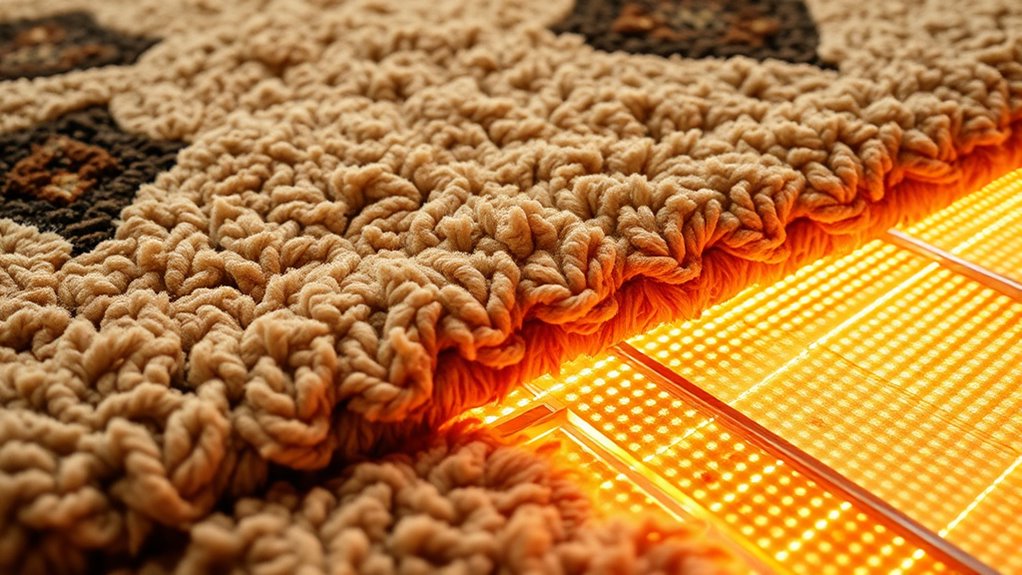
Understanding thermal resistance is essential when choosing rugs for under-floor heating because it determines how well a material allows heat to pass through. Basically, thermal resistance measures how much a material resists heat transfer. A rug with high thermal resistance acts as an insulator, trapping heat below and reducing efficiency. Conversely, a low thermal resistance allows more heat to flow through, making the under-floor heating system more effective. When selecting a rug, you need to take into account its thermal resistance to ensure it doesn’t hinder heat flow. If the rug insulates too much, your floor may stay cold, and your heating system will work harder. Additionally, considering the material composition of the rug can help optimize heat transfer and energy efficiency. By understanding this property, you can choose a rug that balances comfort and energy efficiency, ensuring your flooring stays warm without sacrificing performance.
How Heat Moves Through Different Materials
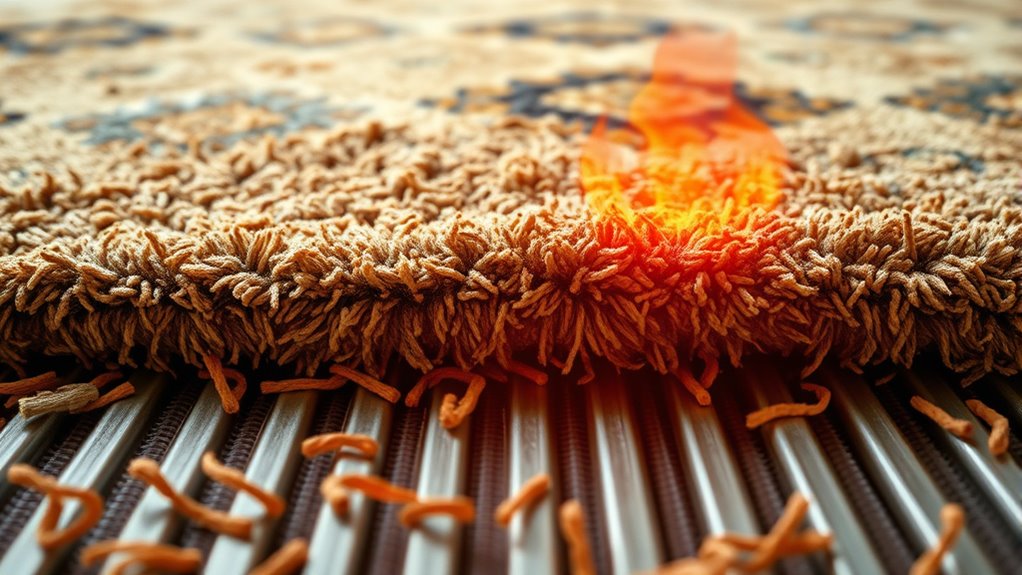
You’ll notice that some materials easily transfer heat, while others act as barriers. The conductivity of each material determines how quickly heat moves through it. Insulation and resistance also play key roles in controlling heat flow and keeping your space warm. In applications like Honda Tuning, understanding material thermal resistance is essential for optimizing performance and efficiency.
Conductivity of Materials
The ability of a material to conduct heat directly affects how effectively under-floor heating systems warm a space. Materials with high thermal conductivity, like metals, transfer heat quickly and efficiently, ensuring your floor warms evenly. Conversely, materials with low conductivity, such as wood or certain plastics, slow down heat transfer, making heating less effective. When selecting flooring, consider the conductivity to optimize heat distribution. For example, tiles and concrete have high conductivity, allowing rapid heat transfer, while carpets and rugs insulate, reducing heat flow. Understanding conductivity helps you choose materials that maximize comfort and efficiency. Additionally, the type of headphone jack used in your devices can influence audio quality and compatibility, which is important for enjoying multimedia content comfortably. Keep in mind, the goal is to balance heat transfer with insulation needs, ensuring your system works effectively without wasting energy.
Insulation and Resistance
Materials with high insulation properties resist heat flow, affecting how effectively your under-floor heating system warms a room. When you use insulating materials, they slow down heat transfer, trapping warmth closer to the floor. This can improve comfort and energy efficiency, but it may also reduce the heat reaching the room’s upper areas if the insulation is too thick or dense. Different materials have varying resistance levels, which impact how much heat passes through them. For example, carpets and rugs with thick padding increase resistance, acting as barriers to heat flow. Conversely, materials with low resistance allow heat to pass more freely, helping your system heat the space quickly. Understanding these differences helps you choose the right flooring and coverings to maximize your under-floor heating’s performance.
Understanding the Role of Rugs in Heat Retention
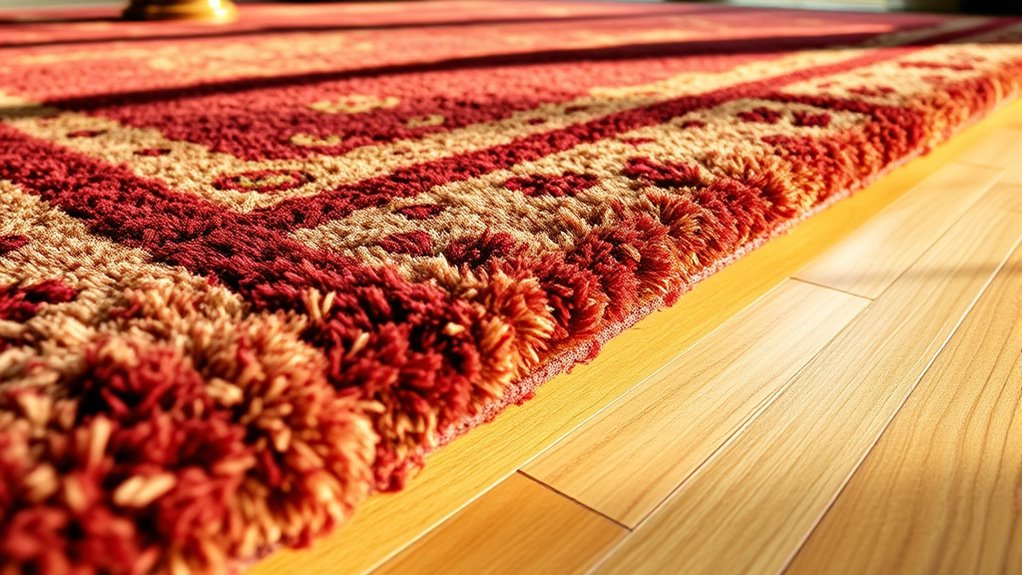
The material and insulation properties of your rug markedly influence heat retention. Thicker rugs with air pockets can trap warmth, making your under-floor heating more effective. Choosing the right rug can help you maximize comfort and energy efficiency in your space.
Rug Material and Insulation
Choosing the right rug material can considerably influence how well your space retains heat, especially when combined with under-floor heating systems. Natural fibers like wool have excellent insulation properties, trapping air and reducing heat loss. Wool’s dense fibers create a barrier that helps keep warmth in, making it an ideal choice for thermal retention. Synthetic materials like nylon or polyester are less insulating but often more durable and affordable. The insulation quality of a rug depends largely on the fiber’s density and structure, not just thickness. A tightly woven rug made from insulating materials will perform better in retaining heat than a loose or thin rug. Selecting the right material helps maximize your under-floor heating’s efficiency and keeps your space warmer. Additionally, choosing user-friendly rug options can enhance ease of maintenance and overall comfort in your heated space.
Thickness and Air Traps
Thicker rugs with greater padding and multiple layers can considerably enhance heat retention by creating air traps that insulate your space. These air pockets act as barriers, reducing heat loss through conduction. To maximize this effect, consider:
- Choosing rugs with dense padding or thick fibers for better insulation.
- Layering rugs to increase air space and trap more heat.
- Ensuring the rug covers the entire heated area to prevent heat escape.
- Avoiding thin or sparse materials that allow heat to pass through easily.
The Impact of Rug Thickness and Material on Heat Flow
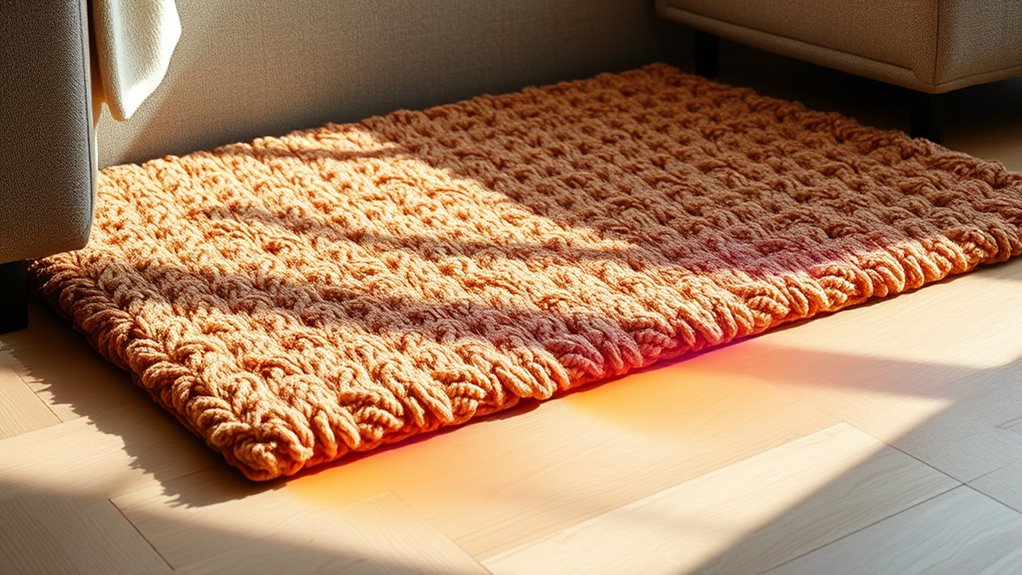
While rug thickness and material directly influence heat flow, understanding their impact can help you make smarter choices for under-floor heating efficiency. Thicker rugs and dense materials tend to insulate better, reducing heat transfer. Conversely, thinner or breathable fabrics allow more warmth to pass through. The table below highlights how different rug materials and thicknesses affect heat flow:
| Material | Thickness | Heat Transfer Effect |
|---|---|---|
| Wool | Thick (~1 cm) | Reduces heat flow |
| Cotton | Thin (~0.2 cm) | Allows more heat |
| Synthetic (polyester) | Medium (~0.5 cm) | Moderate transfer |
| Jute | Thick (~1 cm) | Significant insulation |
| Bamboo | Thin (~0.3 cm) | Enhances heat flow |
Choosing the right combination ensures comfort without compromising your heating system’s efficiency. Understanding insulation properties can further optimize your setup.
How Under-Floor Heating Systems Generate and Distribute Warmth
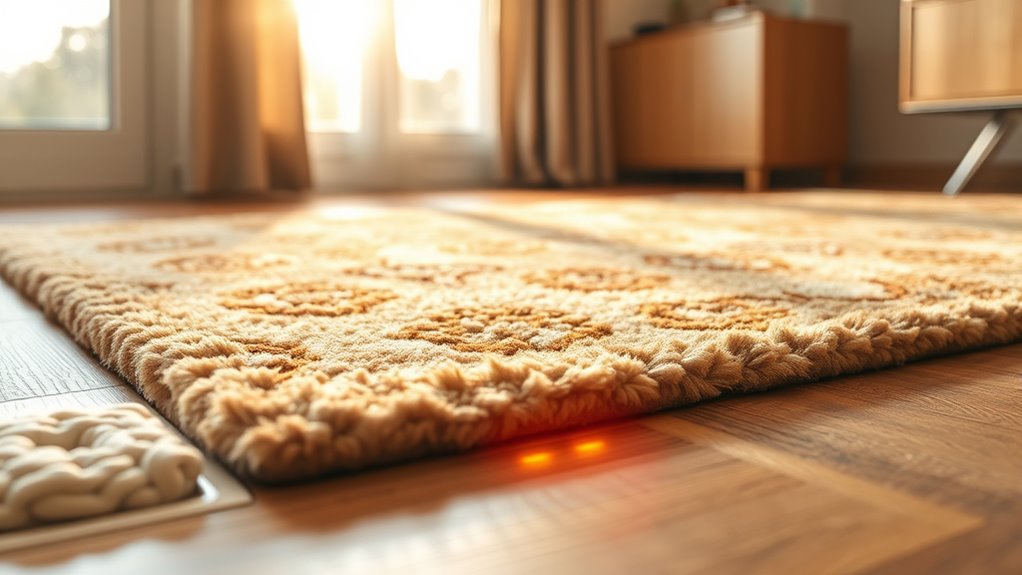
Under-floor heating systems generate warmth through electric cables or water pipes installed beneath your floor. This heat then radiates upward, warming the room evenly. Understanding how this heat is produced and spread helps you optimize your comfort and energy efficiency. The effectiveness of this system is also influenced by the thermal resistance of the flooring materials, which determines how well heat passes through the surface.
Heat Generation Methods
Under-floor heating systems generate warmth primarily through electric or hydronic methods, both designed to evenly distribute heat across a room’s surface. Electric systems use cables or mats embedded in the floor, heating up when powered. Hydronic systems circulate heated water through pipes, warming the floor from beneath. Here’s how these methods work:
- Electric cables or mats are installed under the floor, converting electricity into heat.
- Hydronic systems pump heated water through a network of pipes beneath the surface.
- Thermostats regulate temperature, ensuring consistent warmth.
- Energy sources like electricity or boilers power these systems efficiently.
Both methods focus on generating heat directly at the floor level, providing comfort and efficiency without relying on traditional radiators.
Warmth Distribution Dynamics
Understanding how under-floor heating systems distribute warmth helps you appreciate their efficiency and comfort. These systems generate heat through a network of pipes or electric mats beneath your floor. Once activated, heat rises evenly from the surface, warming the entire room uniformly. Unlike radiators that create hot spots near their source, under-floor heating spreads warmth across the entire floor area, reducing temperature gradients. The heat transfer occurs mainly through conduction and radiation, ensuring a gentle, consistent warmth. As the floor warms, it radiates heat upward, reaching your feet and lower body first, then spreading throughout the space. This dynamic results in a cozy environment where you feel uniformly warm without drafts or cold spots, making your living space both comfortable and energy-efficient.
Choosing the Right Rug to Complement Your Heating System
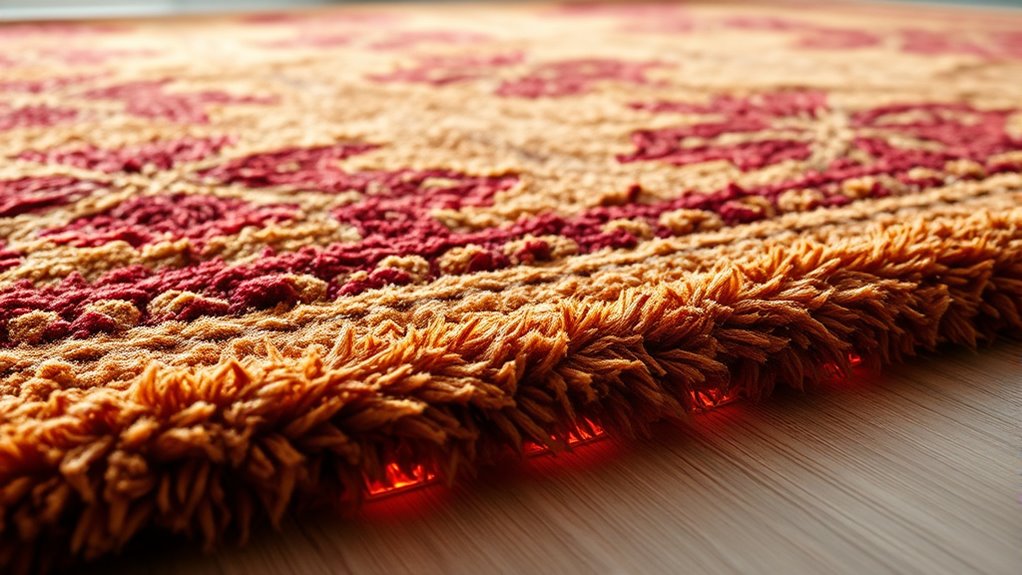
Choosing the right rug is essential to maximizing the efficiency and comfort of your heating system. The rug’s material, thickness, and size can impact heat transfer and overall warmth. To help you select the best options, consider these factors:
- Material: Opt for natural fibers like wool, which have moderate thermal resistance, or synthetic fibers for lower resistance.
- Thickness: Thinner rugs allow better heat transmission than thick, plush ones that insulate heat.
- Size: Cover as much floor area as possible without blocking vents or vents to distribute heat evenly.
- Pattern and Color: Lighter colors reflect heat, while darker shades absorb and retain warmth, complementing your heating system’s efficiency.
- Proper Rug Placement can enhance heat flow and prevent heat loss through insulating materials.
Choosing wisely guarantees your space stays warm while your system operates efficiently.
Measuring the Thermal Resistance of Various Rug Materials
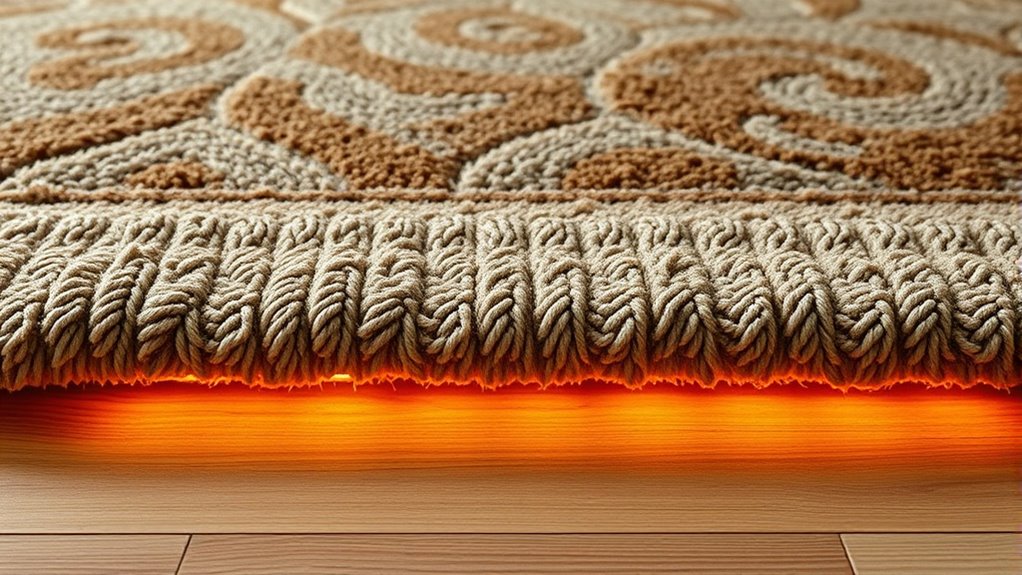
To determine how well a rug allows heat to pass through, you need to measure its thermal resistance. This value indicates how much the material resists heat flow. To do this, you can use a thermal resistance tester or a guarded hot plate apparatus, which measures the heat transfer rate through a sample. First, select a representative piece of your rug material. Place it between a warm plate and a cold plate, ensuring good contact. Then, record the heat flow and temperature difference. The thermal resistance (R-value) is calculated by dividing the temperature difference by the heat flow. A higher R-value means more resistance to heat transfer. Knowing this helps you choose rugs that suit your under-floor heating system’s efficiency and comfort goals. Proper understanding of thermal resistance is essential for optimizing energy efficiency in your home.
Practical Tips for Optimizing Home Warmth and Energy Efficiency
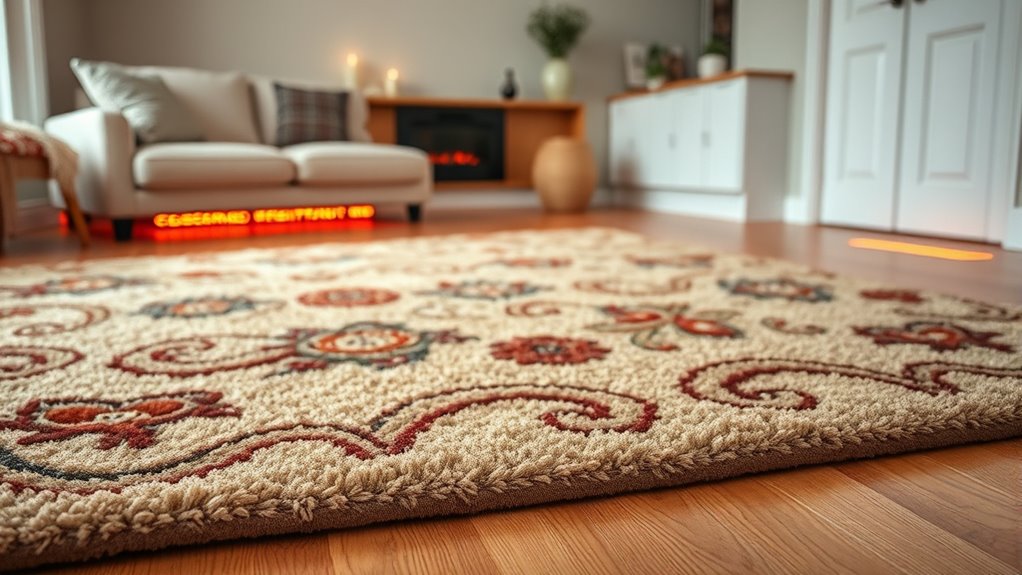
Maximizing your home’s warmth and energy efficiency involves implementing simple, effective strategies that can make a noticeable difference. Start by:
- Use rugs with low thermal resistance over under-floor heating to improve heat transfer.
- Seal drafts around windows and doors to prevent heat loss.
- Optimize thermostat settings, keeping the temperature steady rather than frequently adjusting.
- Insulate floors and walls to reduce heat escape, especially in colder months.
Additionally, consider zoning your heating system to target frequently used areas and avoid unnecessary heating in unused spaces. Regularly maintain your under-floor heating system to ensure it runs efficiently. These small changes can markedly boost warmth and reduce energy bills, making your home more comfortable and eco-friendly.
Common Mistakes When Combining Rugs With Under-Floor Heating
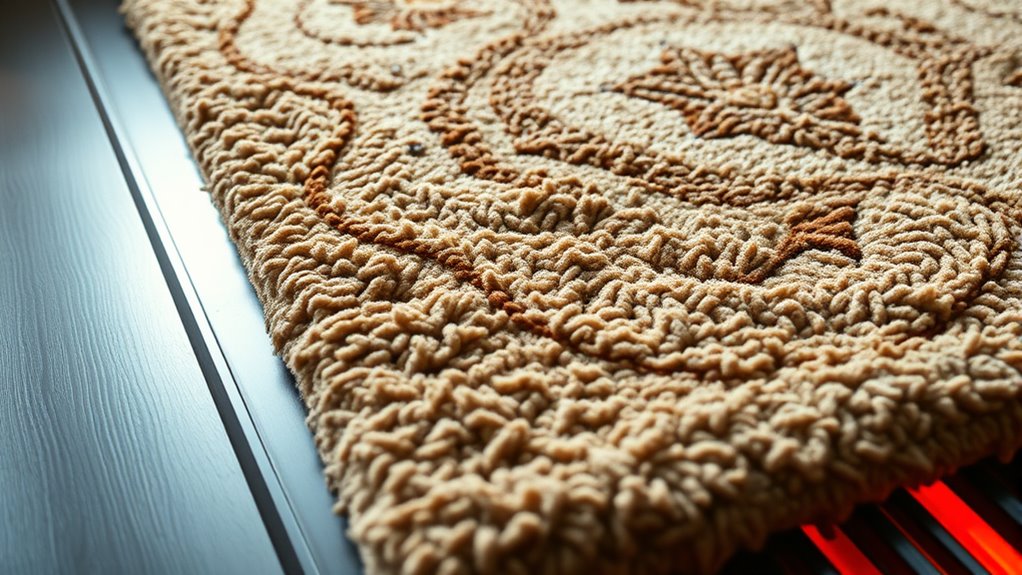
While adding rugs can enhance comfort and style, combining them with under-floor heating requires careful consideration. Common mistakes include using thick or dense rugs that trap heat, reducing efficiency and warmth. Avoid placing rugs directly over thermostats or heating elements, which can cause uneven heating. Also, selecting rugs made of materials with high thermal resistance can hinder heat transfer. To prevent these issues, choose thin, breathable rugs and keep them away from heat sources. Additionally, understanding the thermal resistance of rug materials is crucial for optimal heat transfer. Here’s a quick guide:
| Mistake | Impact | Solution |
|---|---|---|
| Thick or dense rugs | Blocks heat flow | Use lightweight, breathable rugs |
| Covering thermostats | Disrupts temperature regulation | Keep thermostats exposed |
| High-resistance materials | Reduces heat transfer | Opt for low-resistance fabrics |
Being mindful of these mistakes ensures your rugs complement your under-floor heating system effectively.
Factors to Consider for a Comfortable and Cost-Effective Heating Setup
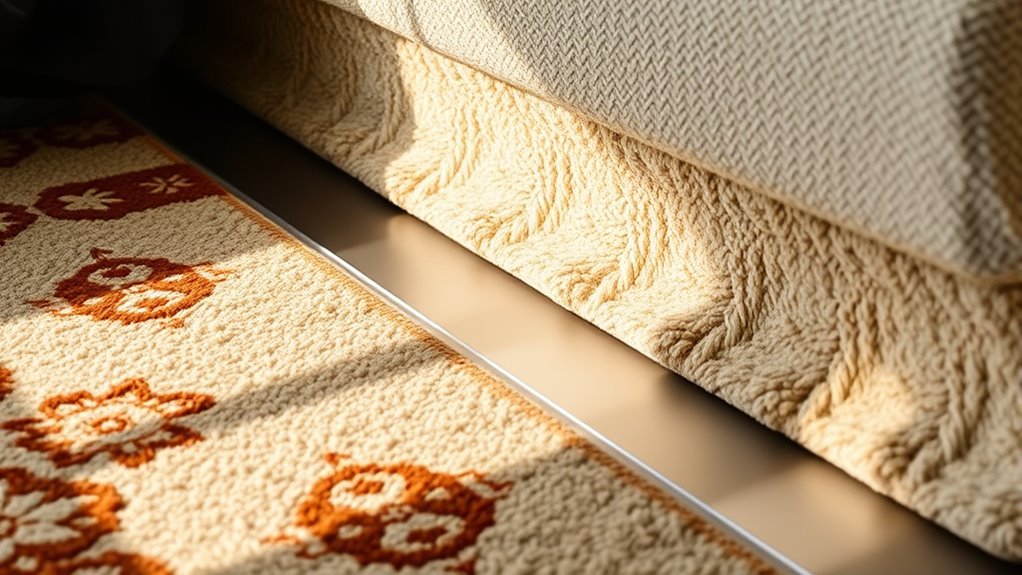
Are you aware of the key factors that can make your under-floor heating both comfortable and budget-friendly? First, consider the insulation quality beneath your flooring—good insulation reduces heat loss and lowers energy costs. Second, select rugs with low thermal resistance to allow heat to pass through efficiently. Third, set your thermostat wisely; avoid excessive temperatures that waste energy. Fourth, choose a heating system compatible with your flooring type and rug thickness to ensure even heat distribution. Additionally, understanding the thermal resistance of your rugs helps optimize heating efficiency. By focusing on insulation, rug choice, temperature settings, and system compatibility, you can optimize comfort while keeping costs down. Paying attention to these factors helps create a cozy space without unnecessary energy expenditure.
Frequently Asked Questions
How Does Rug Color Affect Heat Retention in Under-Floor Heating?
You might wonder how rug color impacts heat retention. Darker colors absorb more heat, helping retain warmth longer, while lighter shades reflect heat, reducing their effectiveness in retaining warmth. If you want to maximize your under-floor heating, opt for darker rugs to absorb and hold more heat. Conversely, lighter rugs might keep the room cooler and reflect heat, making them less ideal for warmth retention with under-floor heating.
Can Rug Placement Influence the Efficiency of Under-Floor Heating Systems?
Yes, your rug placement can influence the efficiency of your under-floor heating system. If you place a thick or dense rug directly over the heater, it can act as an insulator, reducing heat transfer into the room. To maximize efficiency, position rugs carefully, avoiding thick coverings in high-traffic or heated zones, and consider using thinner rugs or mats that allow heat to pass through more easily.
Are There Specific Rug Styles Best Suited for Thermal Insulation?
You’re asking if specific rug styles are best for thermal insulation. While no single style is a magic bullet, thicker, plush rugs with dense fibers generally do a better job at trapping heat. Low-pile rugs tend to let heat escape more easily. To get the most out of your under-floor heating, choose rugs with high thermal resistance. It’s all about hitting two birds with one stone—comfort and efficiency.
How Do Environmental Factors Impact the Thermal Resistance of Rugs?
Environmental factors considerably influence a rug’s thermal resistance. When you place a rug in a humid or damp environment, it can absorb moisture, reducing its insulating properties and making it less effective at retaining heat. Conversely, in dry conditions, a rug maintains its insulating capabilities better. Temperature fluctuations and exposure to sunlight can also degrade rug fibers over time, impacting their ability to insulate effectively.
What Maintenance Practices Help Preserve a Rug’s Thermal Properties?
You can preserve your rug’s thermal properties by regularly vacuuming it to remove dirt and debris that can trap heat. Rotate the rug periodically to prevent uneven wear, which may affect insulation. Avoid excessive moisture and clean spills promptly to prevent damage. Using appropriate cleaning methods and avoiding harsh chemicals helps maintain the rug’s fibers, ensuring it continues to insulate effectively and supports your under-floor heating system efficiently.
Conclusion
By choosing the right rug and understanding its thermal resistance, you’re fundamentally tuning your home’s cozy symphony. Think of your flooring as a delicate dance, where each material plays a part in keeping warmth in and cold out. With mindful selection and smart placement, you’ll turn your space into a warm embrace — a sanctuary where comfort flows seamlessly, and energy efficiency becomes your loyal partner in the dance of everyday living.








